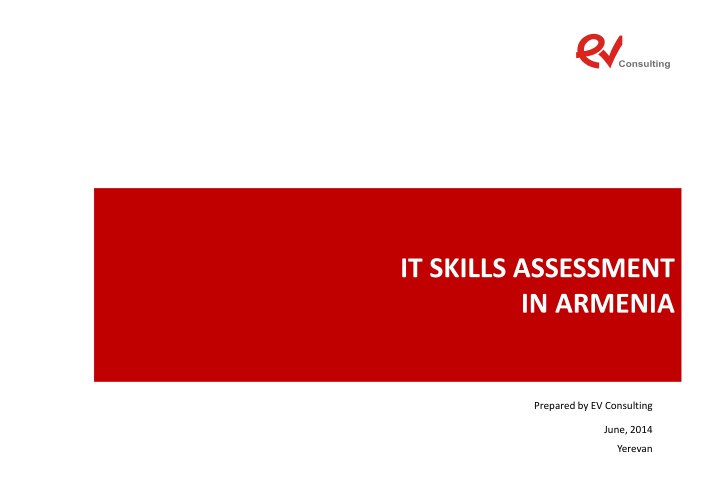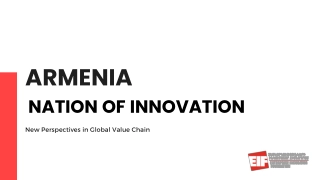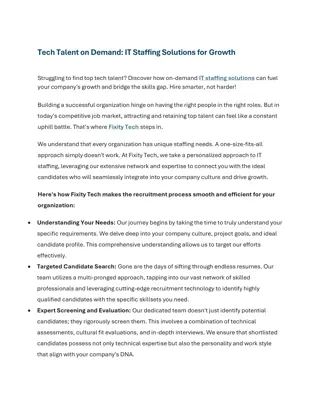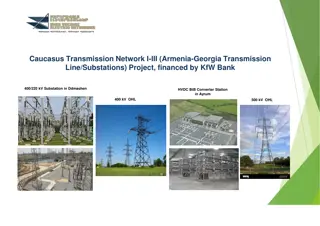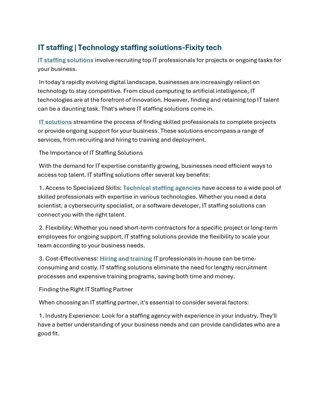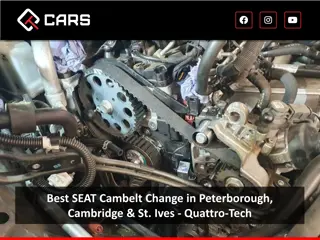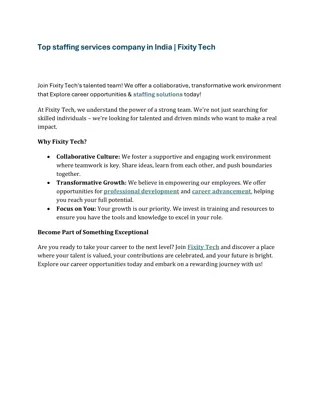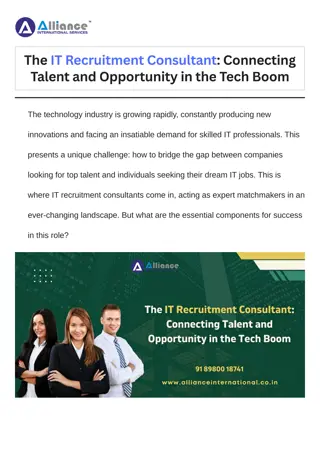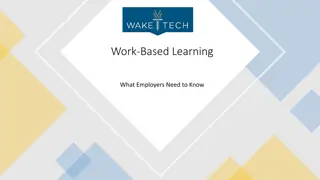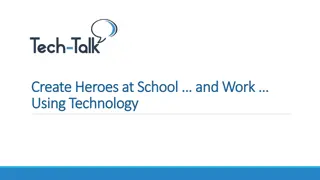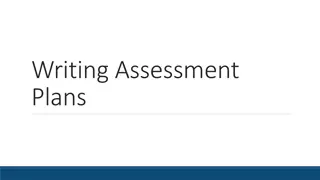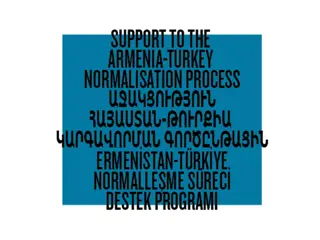IT Skills Assessment in Armenia: Overview of Growing High-Tech Sectors
The IT and high-technology sectors in Armenia have experienced significant growth, with increasing industry turnover, productivity, and number of employees. The sector is supported by a dynamic ecosystem of training centers, labs, multinational companies, and entrepreneurial initiatives. To sustain this growth, the sector focuses on maintaining outsourcing capabilities and fostering higher value-added entrepreneurial models.
Download Presentation

Please find below an Image/Link to download the presentation.
The content on the website is provided AS IS for your information and personal use only. It may not be sold, licensed, or shared on other websites without obtaining consent from the author.If you encounter any issues during the download, it is possible that the publisher has removed the file from their server.
You are allowed to download the files provided on this website for personal or commercial use, subject to the condition that they are used lawfully. All files are the property of their respective owners.
The content on the website is provided AS IS for your information and personal use only. It may not be sold, licensed, or shared on other websites without obtaining consent from the author.
E N D
Presentation Transcript
IT SKILLS ASSESSMENT IN ARMENIA Prepared by EV Consulting June, 2014 Yerevan
Contents Overview of the sector Demand side analysis of skills gap Supply side analysis of skills gap Recommendations 2
IT and High technology sectors are one of the fastest growing sectors in the economy of Armenia. Industry turnover, labor productivity and number of employees, 2006-2013 350,000 ~3% of GDP CAGR: 22% 14,000 294,000 300,000 12,000 250,000 10,000 7,996 200,000 ~0.7% of total labor force CAGR: 10% 8,000 150,000 6,000 4,021 100,000 4,000 75,200 36,768 50,000 ~4x higher the average level of economy CAGR: 9% 2,000 - - 18,700 2006 2008 2009 2010 2011 2012 2013 Turnover in thsd USD Productivity Number of technical employees 4
The number of companies operating in the sector has reached to about 380 in 2013 from 175 in 2008. 380 360 CAGR: 22% 281 155 151 197 107 186 175 CAGR: 20% 72 74 56 225 209 174 CAGR: 13% 125 119 112 2008 2009 2010 2011 2012 2013 Local International IT companies (87% of total number) High-tech companies (13% of total number) 5
The dynamic growth of the sector is marked with a number of significant developments Trainings centers Labs and technoparks Multinationals Entrepreneurial ecosystem Microsoft innovation center Armenian National Engineering Laboratory (ANEL) Oracle Granatus Venture Fund I IBM Armenian-Indian ICT Excellence Center Gyumri Information Technology Center mLAB ECA Instigate Training center, etc. 6
The industry has two directions of sustaining its growth: maintaining the outsourcing capabilities and higher value added entrepreneurial model of growth. Sector development Entrepreneurial/higher value added growth Outsourcing capabilities Innovation management, business acumen Low-cost high-quality workforce Venture capital Multinationals entrance Scale-up to international markets FDI 7
Due to growing number of IT companies in Armenia, demand in IT specialists will continue to increase. The forecast of employee absorption potential in IT and High-tech sectors Optimistic scenario Assumptions Market growth rate 18% Productivity growth rate 1% IT specialists absorption potential 17% Pessimistic scenario Base scenario 8
Educational sector needs to quickly adapt and reflect these challenges in order to sustain the sector competitiveness. 9
Demand side analysis of skills gap in Armenian IT and High Technology sector 10
IT and High-technology companies view the mismatch between the supply and the demand of the skilled IT labor as a key factor that hinders the growth of the sector. Qualitative skills gap Quantitative skills gap EMPLOYEE DEMAND 353 Large companies 72 150 employees short-term (3 months) 198 Medium companies 45 600 employees long-term (3 years) 30 Small companies 30 Long-term employee demand Short-term employee demand 11
The demand for new talent in surveyed High technology companies is higher compared to IT companies. Number of demanded IT specialists categorized by IT and High-tech sectors IT IT 61 288 High-tech High-tech 86 293 Short-term demand Short-term demand Long-term demand Long-term demand 12
Software development will remain the most widespread and demanded specialization in the upcoming 3 years. Number of required IT specialists categorized by specialization Breakdown of short-term "Other" category 11 Technical sales specialists 264 Software engineers 10 Technician-installers 54 6 Control automation 4 UI/UX designers 92 Hardware and automation engineers 27 1 Database developers 1 Virtualization specialists 70 1 IT security specialists Web developers 17 Breakdown of long-term "Other" category 78 Mobile developers 7 3D modellers 10 UI/UX designers 7 Hardware technicians 4 38 QA engineers Client support specialists 4 8 Database developers 3 Game developers 3 39 Other Virtualization specialists 2 34 IT security specialists 2 Image processing specialists 1 Technical HR managers 1 Long-term demand Short-term demand Project managers 1 Technical writers 1 13
The main constraint of recruitment for companies is the lack of qualified candidates in the market. Recruitment constraints in IT and Engineering companies Lack of qualified candidates 25 High salary expectations 12 Budget limitations 9 Lack of recruitment staff 2 Lack of future business opportunities 1 Number of respondents: 29 14
The migration trend severely impacts the pool of available IT specialists in Armenia. IT specialists in Armenia Higher compensation seeker with strong personal ties with the country Impactful, creative and global career seekers Leave the country 15
The local small companies with revenue limitations face intensifying competition in hiring local talent, due to high remuneration levels. 16
The quality gap of the skills in IT and High tech is due to low quality of graduates according to the sector companies. Assessment of skills for graduates in IT and Engineering sectors by companies Practical knowledge 45% 28% 17% 7% 3% Theoretical knowledge 3% 31% 45% 17% 3% English 3% 17% 41% 28% 10% Soft skills 10% 17% 45% 14% 14% Poor Fair Average Good Excellent Difficult to answer Number of respondents: 29 Practical capabilities are below expectation - ~73% respondents Theoretical knowledge level is average or below ~80% respondents 17
Soft skills and English knowledge of the graduates are on a more acceptable level compared with theoretical and practical knowledge. Assessment of skills for graduates in IT and Engineering sectors by companies Practical knowledge Practical knowledge 45% 28% 17% 7% 3% Theoretical knowledge 3% 31% 45% 17% 3% English 3% 17% 41% 28% 10% Soft skills 10% 17% 45% 14% 14% Poor Fair Average Good Excellent Difficult to answer Number of respondents: 29 Soft skills are average or above - ~70% respondents English language skills are average or above ~80% respondents 18
Importance of soft skills and fluency in language are crucial for the employers. Share of English-speaking employees in surveyed IT companies Assessment of soft skill importance of job candidates Employees without knowledge of English, 12% Very important 61% Relatively important 29% Employees with knowledge of English, 88% Not important 10% Number of respondents: 28 Number of respondents: 29 19
Companies adjust their recruiting requirements and lower standards due to the lack of qualified candidates. Current company preference for different candidate skills and knowledge and other characteristics 46% 46% 7% University degree 4% 46% 50% Technical knowledge and skills 21% 79% Cultural fit 11% 29% 61% Soft skills 4% 11% 86% Motivation Not important Relatively important Very important Number of respondents: 28 20
The university degree is not a crucial decision factor in recruitment by companies, indicating the diminishing role and image of higher education in the sector due to the insufficient quality of graduates. 21
Only 8% of surveyed companies considered the university degree to be of high-level importance for the recruitment process. 22
Currently, companies consider the Masters degrees to have a limited benefit on top of knowledge gained through undergraduate studies. The current structure of labor force in the sector by university degrees 2% 36% 62% Master's degree and above Bachelor's degree Technical (non-higher) 23
Ability to independently find relevant information, utilize it is a critical requirement and self-educate is currently missing in the majority of graduates. 24
The companies do not differentiate among the faculties and major specializations of the higher education institutions. Companies' preference for the major or discipline of graduates No preference 69% Applied mathematics and informatics 12% Computer systems and informatics 10% Radiophysics and radiotechnology 7% Electronic engineering 2% Number of respondents: 29 25
About 34% of the respondent companies expressed no preference in hiring graduates from particular university. Company preference for recruiting from Armenian universities No preference 34% SEUA 21% YSU 21% RAU 11% AUA 5% Training centers 9% Number of respondents: 28 26
Supply side analysis of skills gap in Armenian IT and High Technology sector 27
The higher education system in Armenia lacks the competitive dynamism and efficiency. Despite the existence of 63 public and private players, the sector lacks an efficient competitive environment: State universities are privileged - providing substantial tuition subsidies and exemptions from army service for students. Armenia is not big enough to afford several universities competing in each discipline so a few have become monopoly providers of education in certain disciplines. Five universities dominate the sector by virtue of their scale of enrollment. Armenian higher educational institutions do not track their performances by international rankings, the statistics on the career development of the graduates, etc. The minimal connection with the global education market means the local market is a captive one. 28
The quest to join European Higher Education Area pressures Armenia to reform, but the pace is still unsatisfactory 7 WEF ranking on the Quality of Educational System, 2013-2014, Score, out of 7 6 5 4 3 2 1 7 WEF ranking on the Quality of Math and Science Education, 2013-2014, Score, out of 7 6 5 4 3 2 1 29
The list of most significant higher education institutions that provide IT and Engineering specializations comprise 5 universities. STATE ENGINEERING UNIVERSITY OF ARMENIA (SEUA) YEREVAN STATE UNIVERSITY (YSU) RUSSIAN-ARMENIAN (SLAVONIC) UNIVERSITY (RAU) AMERICAN UNIVERSITY OF ARMENIA (AUA) EUROPEAN REGIONAL ACADEMY (ERA) 30
For the last 4 years there was no shortage in number of graduates enrolled in IT- related faculties. Number of IT-related students and graduates 8,820 7,075 7,009 6,576 1,959 1,950 1,842 1,657 2009/10 2010/11 2011/12 2012/13 Students Graduates 31
Provided the same tendency of faculty choice, the number of IT graduates will decrease starting from 2014/15 until 2022, with a slight recovery in 2016-2017. Estimated number of graduates from IT-related faculties, 2013/14-2015/16 3,290 2,020 Graduates in IT-related Graduates in ICT-related specialisations specializations 1,720 1,340 Number of ICT specialists required (base scenario) (base scenario) Number of IT specialists required 1,270 190 2013/14 2014/15 2015/16 Assumption 95% of currently enrolled students will graduate. 32
In 2018/19 and 2019/20 the number of the graduates is again expected to diminish due to the recent military reform owing to which males are bound to have a 2-year military service deferring their higher education.
Currently, there is a shortage of graduates in quantitative terms produced by the local higher education system, particularly, for the sector of IT and Engineering. Number of IT and Engineering students and graduates in the universities, 2013/2014 YSU SEUA AUA RAU ERA IT STUDENTS 670 1,650 100 200 90 ENGINEERING STUDENTS 1,390 1,730 50 100 40 TOTAL STUDENTS 2,060 3,380 150 300 130 IT GRADUATES 190 460 25 40 30 ENGINEERING GRADUATES 480 640 25 20 10 TOTAL GRADUATES 670 1,100 50 60 40 34
There is no quantity shortage of teaching staff in IT-related faculties in Armenian universities. Number of teaching staff in universities by IT and Engineering specializations, 2013/2014 388 SEUA 177 211 YSU 120 96 216 RAU 46 43 89 AUA 20 15 35 ERA 18 12 30 IT High-tech 35
The average student-teacher ratios in Armenian universities are quite low compared to international standards, but teaching stuff is gradually aging. Student-to-faculty ratio in local and Western Universities, 2014 Average age of the university lecturers, 2014 YSU SEUA AUA RAU ERA AVERAGE AGE 50 56 45 ~45 ~40 36
There is no set process between universities and companies in terms of organizing internship projects for students, yet there are discussions to make the internships of students an efficient link between the platforms.
Career centers can also serve as a link between universities and the private sector. However, these currently do not operate efficiently and are in their infancy stage.
IT training center services have significant demand from both the students and junior level working professionals. Characteristics and indicators training centers in Armenia MICROSOFT INNOVATION CENTER ARMENIAN-INDIAN IT EXCELLENCE CENTER MLAB ECA TECHNICAL COURSES Available Available Available NON-TECHNICAL DEVELOPMENT COURSES Available Available Available No requirements for beginners, minimum test score/ knowledge for advanced stages Basic programming knowledge required for transferring to mobile programming platforms Basic knowledge and algorithmic thinking PREREQUISITES ANNUAL NUMBER OF GRADUATES ~1,000 ~500 ~300 NUMBER OF INSTRUCTORS 9 10 ~50 AVERAGE AGE OF INSTRUCTORS ~27 ~40 ~33-35 INTERNSHIP Available Not available Not available EMPLOYABILITY RATE 80%-90% N/A 90% 39
Engineering educational centers prepare specialists that meet international quality standards and are almost 100% employed. SYNOPSYS ARMENIA EDUCATIONAL DEPARTMENT INSTIGATE TRAINING CENTER TECHNICAL COURSES Available Available NON-TECHNICAL DEVELOPMENT COURSES Not available Available Strong technical knowledge and algorithmic thinking. Strong knowledge of all technical fundamentals Capacity to solve technical problems, basic mathematical knowledge PREREQUISITES ANNUAL NUMBER OF GRADUATES ~50 ~80 NUMBER OF INSTRUCTORS ~30 67 AVERAGE AGE OF INSTRUCTORS ~30 ~30-35 INTERNSHIP Involvement in company projects Involvement in company projects EMPLOYABILITY RATE 100% 100% 40
There is total absence of professional off-job training program for senior developers on the market, so the companies have no alternative but to provide on-the- job training.
SUMMARY AND HIGH LEVEL RECOMMENDATIONS 42
Only 45% of the graduates consider employment in the sector, thus, creating a quantitative imbalance of workforce. ~2,000 new specialists demanded ~450 graduates IT and High technology sector Whereas, the number of graduates with IT specializations annually about coincides with the annual new demand in the overall market 43
Due to the fast growing industry dynamics there is also a qualitative skills gap Teaching programs are not fit for the private sector standards No effective links between university and private sector Professional standards in teaching staff is low and there is no motivation to requalify Teaching staff is aging The university programs do not accentuate self-development The university degree program is too long in comparison with the industry dynamics Not sufficient number of high-level training programs for base and senior level specialists to requalify 44
High-level SHORT-TERM recommendations and key points for policy makers 1. A new university curriculum should be developed together with the private sector 2. The quota of government funded students should be increased for IT specializations 3. The link between the universities and private sector should be strengthened through transforming the role of mandatory internship/apprenticeship programs. 4. More young professionals should be encouraged to teach to inject the practical skills. 45
High-level SHORT-TERM recommendations and key points for policy makers 5. The need in base and senior level specialists can be satisfied via creation of special training programs. 6. Co-financing schemes for workforce development by means of training centers creation can help smaller companies to close the skill gap. 7. Widespread and targeted communication campaigns shall be organized to highlight the prospects and strong market demand for the engineering profession. 46
High-level LONG-TERM recommendations and key points for policy makers 1. The fundamental reshape of the IT education is recommended to start with the intervention at schools. 2. Simultaneously, the university funding needs considerable increase as well as diversification through research grants and endowment foundations. 3. The number of university-based laboratories, which are established with the help of multinationals, should be scaled up. 4. Creating an alternative program to prepare software programmers in less than 4 years will help increase the supply of labor in the medium term. 47
High-level LONG-TERM recommendations and key points for policy makers 5. The universities should transform their career centers into modern support mechanism for their graduates. 6. If Armenia aspires to transition from outsourcing, development center destination to one of innovation centers functioning under entrepreneurship model, it has to integrate fundamental, hard-core research into its university system. 7. High tech accelerators can become the new type of schools for entrepreneurs. 48
